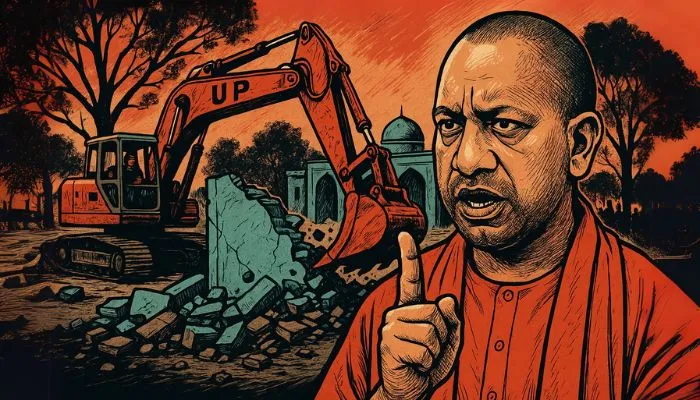13,000 Illegal Madrasas Under Scrutiny—How Deep Does This Indo-Nepal Border Operation Go?

Shravasti, Uttar Pradesh/Nepal Border – In a sweeping operation aimed at curbing illegal encroachments and boosting security along the sensitive Indo-Nepal border, the Uttar Pradesh government has demolished 286 unauthorized religious structures across seven border districts. The move, spearheaded by Chief Minister Yogi Adityanath's administration, includes the demolition of 225 madrasas, 30 mosques, 25 mazars, and six eidgahs—drawing both attention and concern from communities on both sides of the border.
For locals in Shravasti, where the highest number of demolitions occurred, the mood is tense. Amidst the dust and rubble of what once were bustling religious sites, villagers spoke in hushed tones. “My son studied in that madrasa,” said a teary-eyed father in Bhinga tehsil. “We didn’t know it was illegal. All we wanted was education.”
The crackdown, launched in phases since April 2025, follows an earlier wave between April 25–27 when 89 such structures were brought down. Officials say the campaign is not targeted at any religion but is part of a broader effort to reclaim illegally occupied government and forest lands while tightening border security in districts like Bahraich, Lakhimpur Kheri, and Pilibhit.
Why Now? A Matter of National Security
According to state authorities, many of the demolished structures were operating without necessary approvals—some on public land, others on property belonging to schools or the forest department. “This is not about faith; it is about law and order,” said an official in Maharajganj, where over 45 structures were removed. “Encroachments near the international border compromise our surveillance and open loopholes for anti-national activities.”
The state has identified 429 such cases of encroachment so far, and investigations suggest many of these madrasas were recently constructed with financial aid from Gulf countries. A Special Investigation Team (SIT) report submitted last year recommended shutting down nearly 13,000 unregistered madrasas operating dangerously close to the Nepal border.
A Tale of Two Neighbors
The Indo-Nepal border has long been open and porous—something that fosters deep cultural and familial ties between communities on both sides. For many Nepalis, especially in districts like Banke and Bardiya, a day trip to Shravasti or Bahraich is routine. But the sudden and highly publicized demolitions have stirred anxiety.
In Nepalgunj, across the border from Bahraich, community leaders expressed unease. “We understand India’s internal matters are theirs to govern,” said a Nepali civil rights activist, “but such actions can ripple across borders and affect communal harmony.”
Legality, Monitoring, and the Road Ahead
The Uttar Pradesh government insists that every step taken was within the legal framework. Notices were served under Section 67 of the Revenue Code, and structures were reviewed for compliance with the education department and local Waqf Boards. Of the 345 illegal madrasas flagged, 139 have already been sealed.
Meanwhile, monitoring efforts have intensified. State-level agencies are overseeing the campaign, and modern surveillance tools like thermal cameras have been installed across key border points—a measure that began in 2024 after investigative reports revealed alarming demographic shifts and unauthorized religious expansion.
Human Rights and Public Sentiment
Rights groups and local residents alike are watching closely. For many, the demolitions represent a complex crossroad—balancing national integrity with religious and community sentiment. "You can't demolish decades of faith in a day," said a resident in Balrampur, "even if the structure was illegal, the emotions attached to it were real."
Conclusion
As bulldozers clear what was once sacred ground for many, the echoes of chants and prayers may fade, but the debate on identity, legality, and security will likely linger. For now, the border districts stand as symbols of a broader national conversation—one that affects not just India, but its deeply intertwined neighbor, Nepal.




![From Kathmandu to the World: How Excel Students Are Winning Big [Admission Open]](https://nepalaaja.com/img/70194/medium/excel-college-info-eng-nep-2342.jpg)
